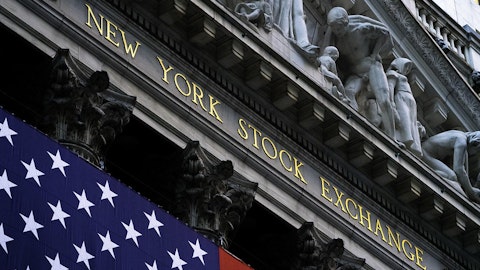In this article, we discuss 12 bank stocks to buy according to Goldman Sachs.
Bank executives entered 2025 with cautious optimism, as inflation eased and interest rates were dipping, but slow economic growth, global tensions, and regulatory uncertainty kept them on edge. Still, a Deloitte report mentioned that many bankers will be relieved to move on from 2024.
This cautious sentiment set the stage for economic forecasts that pointed to both opportunities and challenges. In 2025, American GDP growth was projected to slip to 1.5% under Deloitte’s baseline forecast, with risks ranging from weaker consumer spending and rising unemployment to global conflicts and trade barriers. However, a technology-led productivity boost could lift growth closer to 1.9%, while persistent inflation could slow it to 1%.
These projections were closely linked to central banks’ monetary policy choices, which were expected to shape the global financial environment. The European Central Bank may lower rates to 2.75% by the end of the year, while the Bank of England and Bank of Canada are likely to cut rates as well. The Bank of Japan, however, could face more constraints as it tries to manage slow growth and inflation after years of deflation. Overall, most economies will move toward easing, though rate changes may not happen at the same pace everywhere.
Against this global backdrop, the US financial industry is looking at the second half of 2025 with cautious optimism. After being hit by tariff hikes earlier this year, banks now feel more confident about handling policy changes. They forecast robust consumer spending, reduced interest rates, and positive impacts from new regulations and artificial intelligence. At the Morgan Stanley US Financials Conference in June, executives said investment banking should improve, with higher mergers, acquisitions, and IPOs likely, especially if the Federal Reserve continues to cut rates.
Regulatory shifts were seen as another important driver of sentiment. Banks expect proper guidelines under the Trump administration to enhance activity, especially in M&A. Crypto is also gaining traction as new regulations make it convenient for banks and asset managers to offer digital asset products, though building the necessary infrastructure will still take time.
In this article, we will take a look at the best bank stocks to buy according to Goldman Sachs.

Roman Tiraspolsky/Shutterstock.com
Our Methodology
For this article, we manually searched the portfolio of Goldman Sachs as of Q2 2025, handpicking the bank stocks where the institutional investor had the highest stakes. The stocks are ranked according to Goldman Sachs’ stake value, and the hedge fund sentiment as of the June quarter is also mentioned for further context.
Why are we interested in the stocks that hedge funds pile into? The reason is simple: our research has shown that we can outperform the market by imitating the top stock picks of the best hedge funds. Our quarterly newsletter’s strategy selects 14 small-cap and large-cap stocks every quarter and has returned 373.4% since May 2014, beating its benchmark by 218 percentage points (see more details here).
12. Fidelity National Information Services, Inc. (NYSE:FIS)
Number of Hedge Fund Holders: 49
Goldman Sachs’ Stake Value: $739,238,897
Fidelity National Information Services, Inc. (NYSE:FIS) is one of the best Goldman Sachs bank stocks. On August 5, Raymond James trimmed the price target on Fidelity National to $88 from $95, while assigning an Outperform rating on the stock following the Q2 2025 earnings.
The company announced a slight 1% sales beat, with adjusted earnings per share matching estimates. Adjusted EBITDA margins were the same as last year, falling short of Street expectations for a 20 basis point gain. FIS presently carries a P/E ratio of 45.33, supported by 2.92% revenue growth over the past year.
Raymond James cited weaker-than-anticipated margin guidance for Q3, as FIS projected 60 basis points of growth compared to the expected 150 basis points, and shifted its full-year margin forecast downward.
The lowered price target led to an 8% drop in FIS shares, with Raymond James observing that it reflects growing investor concerns over competitive and pricing dynamics.
Although challenges persist, Raymond James upheld its Outperform rating, noting that FIS’s full-year guidance for FX-adjusted organic revenue and adjusted EPS is mostly intact, given the minor interest and tax tailwinds.
Fidelity National Information Services, Inc. (NYSE:FIS) is a global financial technology company that provides banking, payments, risk management, compliance, wealth, and trading solutions.
11. Citigroup Inc. (NYSE:C)
Number of Hedge Fund Holders: 102
Goldman Sachs’ Stake Value: $804,002,702
Citigroup Inc. (NYSE:C) is one of the best Goldman Sachs bank stocks. On September 25, Citi shares, valued at $187.7 billion, shot higher after striking a deal to sell a 25% Banamex stake for around $2.3 billion.
TD Cowen reiterated its Hold rating on Citi with a $95 target, noting that the sale is a positive step toward simplifying the company’s model and trimming its worldwide operations.
This sale is part of Citi’s broader push to retreat from legacy international markets, with leadership focusing on its goal of a full Banamex exit.
In spite of the positive momentum, TD Cowen maintains a neutral outlook, cautioning investors that stablecoin adoption under the Genius Act could weigh on Citi’s Services arm.
The bank’s shares have rallied 73.5% in a year, far above the 15% industry median, indicating that recent strength may already factor in good news.
10. The Charles Schwab Corporation (NYSE:SCHW)
Number of Hedge Fund Holders: 100
Goldman Sachs’ Stake Value: $821,879,201
The Charles Schwab Corporation (NYSE:SCHW) is one of the best Goldman Sachs bank stocks. On September 15, Charles Schwab’s core net new assets came in at $44.4 billion for August 2025, a 35% jump from the prior year.
The company reported $11.23 trillion in client assets as of August, a 15% year-over-year increase and a 2% rise compared to July 2025, aligning with its 52.5% annual stock return.
The firm opened 382,000 brokerage accounts in August, up 18% from last year, as total active accounts expanded to 37.8 million, a 5% year-over-year increase.
The Charles Schwab Corporation (NYSE:SCHW) saw margin loan balances rise 6% on the month to $90.4 billion, a 23% boost from a year ago, while daily trades punched in above 7 million for the eighth month consistently. According to the report, derivatives represented 22.5% of trading volume, 170 basis points higher than a year ago.
At the close of August, transactional sweep cash stood at $406.7 billion, down $0.8 billion, driven by a decline in client net buying. Client cash remained at 9.5% of assets, consistent with the prior year. According to the company’s release, ETFs saw $23 billion in net inflows in August, while mutual funds lost $2.2 billion.





